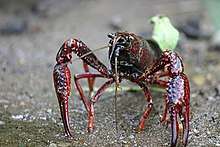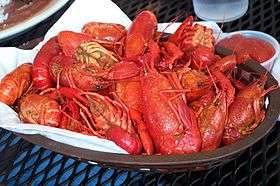Procambarus clarkii
Procambarus clarkii is a species of cambarid freshwater crayfish, native to northern Mexico, and southern and southeastern United States, but also introduced elsewhere (both in North America and other continents), where it is often an invasive pest.[1] It is known variously as the red swamp crayfish, Louisiana crawfish, or mudbug.[3]
| Procambarus clarkii | |
|---|---|
 | |
| Scientific classification | |
| Kingdom: | |
| Phylum: | |
| Subphylum: | |
| Class: | |
| Order: | |
| Family: | |
| Genus: | |
| Subgenus: | |
| Species: | P. clarkii |
| Binomial name | |
| Procambarus clarkii | |
Appearance
P. clarkii is typically dark red, with long claws and head, small or no spines on the sides of its carapace just below the head, and rows of bright red bumps on the front and side of the first leg.[4]
Range and range expansion
The native range of P. clarkii is from northern Mexico and far southeastern New Mexico, through the Gulf States to the Florida Panhandle, as well as north through the Mississippi Basin to southern Illinois and Ohio.[1][4] It has also been introduced, sometimes deliberately, outside its natural range to countries in Asia, Africa, Europe, and elsewhere in the Americas.[1][4] In northern Europe, the populations are self maintaining, but not expanding, while in southern Europe, P. clarkii is multiplying and actively colonising new territory, at the expense of the native crayfish, Astacus astacus and Austropotamobius spp. Individuals are reported to be able to cross many miles of relatively dry ground, especially in wet seasons, although the aquarium trade and anglers may have hastened the spread in some areas ( anglers using P. clarkii as bait are thought to have introduced it to the American state of Washington). Attempts have also been made to use P. clarkii as a biological control organism, to reduce levels of the snails involved in the lifecycle of schistosomiasis, leading to the dispersal of P. clarkii in, for instance, Kenya.
Ecology

P. clarkii is most commonly found in warm fresh water, such as slowly flowing rivers, marshes, reservoirs, irrigation systems and rice paddies. It is considered to be the most ecologically plastic species in the order Decapoda, and is able to grow quickly even in only seasonally present water, being able to tolerate dry spells of up to four months. P. clarkii grows quickly, and is capable of reaching weights in excess of 50 g (1.8 oz), and sizes of 5.5–12 cm (2.2–4.7 in) long.[5] It is also able to tolerate slightly saline water, which is unusual for a crayfish. Additionally, P. clarkii are physiologically capable of tolerating relatively low dissolved oxygen concentrations.[6] The average lifetime of Procambarus clarkii is five years. Some individuals are known to have reached ages (in nature) of over six years.
The burrowing activities of P. clarkii can lead to damage to water courses and to crops, particularly rice, and its feeding can disrupt native ecosystems. It may out-compete the native crayfish species, and is a vector for the crayfish plague fungus Aphanomyces astaci, for crayfish virus vibriosis, and a number of worms parasitic on vertebrates. Their burrowing activities may also be a threat to civil infrastructure such as storm ponds and levees.[7]
Economic importance
Harvests of P. clarkii account for a large majority of the crayfish produced in the United States and elsewhere. Crayfish farming began in Louisiana in the 18th century, taking place in rice fields in a concurrent or alternate culture system. The concurrent culture of rice and crayfish makes good use of land, resources, equipment, and infrastructure already being used for rice production. However, crawfish production has decreased in recent years due to an increase of imports from China, which is now the world's leading producer of crawfish and is also using a rice-based system.[8] A number of species of crustaceans were introduced to China to create markets for aquaculture and because they are better adapted to growing in a rice field than native fish species. Rice-fish farming originated in China and is once again growing as the yields from Green Revolution practices used to grow rice are no longer increasing, and resources such as land and water are becoming more limited.[9]
P. clarkii has also been introduced elsewhere for cultivation, such as Spain, where its success is attributable to its ability to colonise disturbed habitats that would be unsuitable for the native crayfish (Astacus astacus). P. clarkii is also marketed by biological supply companies for teaching and research. P. clarkii also exhibits different color morphs, including white, blue, and orange, which are commonly sold in pet stores.
The introduction of P. clarkii has also resulted in economic losses in some regions. In the Baixo Mondego region of Portugal, it caused a decrease in 6.3% of profits in rice fields.[10] However, this was on a wet-seeded field. All negative effects of crawfish can be avoided if adult crawfish are separated from the seed and seedlings.[11]
As food

P. clarkii is eaten in the United States, Cambodia, Europe, China, Africa, Australia, Thailand, Canada, New Zealand, and the Caribbean. About 98% of the crayfish harvested in the United States come from Louisiana, where the standard culinary term is "crawfish".
Louisiana in 1990 produced 90% of the crawfish in the world and consumed 70% locally.[12]
Louisiana crawfish are usually boiled in a large pot with heavy seasoning (salt, cayenne pepper, lemon, garlic, bay leaves, etc.) and other items such as potatoes and corn on the cob. Many differing methods are used to season the dish, and there are an equal number of opinions on which one is correct.[13] They are generally served at a gathering known as a crawfish boil.
Reproduction
Procambarus clarkii normally reproduces sexually, but research suggests it may also reproduce by parthenogenesis.[14] Can reproduce throughout the year
References
- K. A. Crandall (2010). "Procambarus clarkii". IUCN Red List of Threatened Species. 2010: e.T153877A4557336. doi:10.2305/IUCN.UK.2010-3.RLTS.T153877A4557336.en.
- C. Girard (1852). "A revision of the North American astaci, with observations on their habits and geographic distribution". Proceedings of the Academy of Natural Sciences of Philadelphia. 6: 87–91.
- "Seafood List Search Returns". FDA Acceptable Seafood Name Database. 2008. Retrieved July 17, 2010.
- Nagy, R., A. Fusaro, and W. Conard (17 November 2016). "Procambarus clarkii". Nonindigenous Aquatic Species Database, Gainesville, FL. USGS. Retrieved 14 June 2017.CS1 maint: uses authors parameter (link)
- "Procambarus clarkii (crustacean)". Global Invasive Species Database. March 31, 2006. Retrieved January 31, 2010.
- Bonvillain, Christopher P.; D. Allen Rutherford; William E. Kelso; Christopher C. Green (2012). "Physiological biomarkers of hypoxic stress in red swamp crayfish Procambarus clarkii from field and laboratory experiments". Comparative Biochemistry and Physiology A. 163: 15–21. doi:10.1016/j.cbpa.2012.04.015.
- Metcalfe, John (31 August 2017). "Southern Crawfish Are the Newest Scourge to Northern Infrastructure". Citylab. Retrieved 1 September 2017.
- W. Ray McClain & Robert P. Romaire. "Crawfish culture: A Louisiana aquaculture success story" (PDF). World Aquaculture. 35 (4): 31–35, 60–61.
- Miao Weimin (2010). "Recent developments in rice-fish culture in China: a holistic approach for livelihood improvement in rural areas". Success Stories in Asian Aquaculture. pp. 15–40. doi:10.1007/978-90-481-3087-0_2. ISBN 978-90-481-3087-0.
- Pedto M. Anastácio; Vasco S. Parente & Alexandra M. Correia (2005). "Crayfish effects on seeds and seedlings: identification and quantification of damage". Freshwater Biology. 50 (4): 697–704. doi:10.1111/j.1365-2427.2005.01343.x.
- "Archived copy" (PDF). Archived from the original (PDF) on 2016-04-11. Retrieved 2011-04-10.CS1 maint: archived copy as title (link)
- Larry W. de la Bretonne Jr. & Robert P. Romaire (1990). "Crawfish production: harvesting, marketing and economics" (PDF). SRAC Publication. Southern Regional Aquaculture Center. 42. Archived from the original (PDF) on 2010-12-12.
- How to Season a Crawfish Boil
- G. H. Yue; G. L. Wang; B. Q. Zhu; C. M. Wang; Z .Y. Zhu; L. C. Lo (2008). "Discovery of four natural clones in a crayfish species Procambarus clarkii". International Journal of Biological Sciences. 4 (5): 279–282. doi:10.7150/ijbs.4.279. PMC 2532795. PMID 18781225.
Further reading
- M. James Norrocky (1991). "Observations on the ecology, reproduction and growth of the burrowing crayfish Fallicambarus (Creaserinus) fodiens (Decapoda: Cambaridae) in North-central Ohio". American Midland Naturalist. 125 (1): 75–86. doi:10.2307/2426371. JSTOR 2426371.
External links

- Procambarus clarkii at Animal Diversity Web
